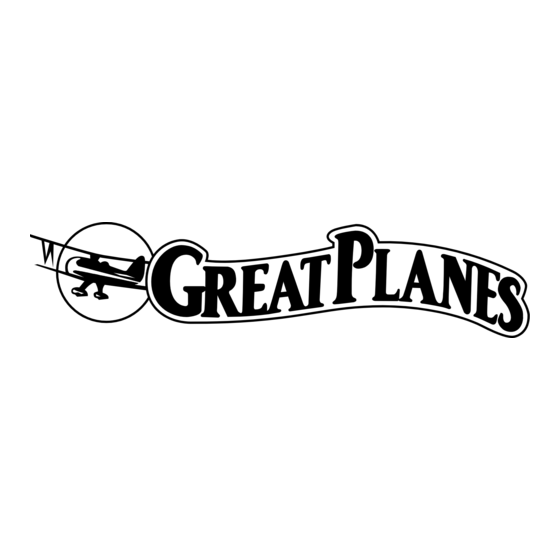GREAT PLANES S.E.5a Manuale di istruzioni - Pagina 17
Sfoglia online o scarica il pdf Manuale di istruzioni per Aerei GREAT PLANES S.E.5a. GREAT PLANES S.E.5a 20.

❏
2. With the wing attached to the fuselage, all parts of the
model installed (ready to fly) and the motor battery installed,
place the model right-side up on a Great Planes CG
Machine, or lift it at the balance point you marked.
❏
3. If the tail drops, the model is "tail heavy" and the motor
battery and/or receiver must be shifted forward or weight
must be added to the nose to balance. If the nose drops, the
model is "nose heavy" and the motor battery and/or receiver
must be shifted aft or weight must be added to the tail to
balance. If possible, move the motor battery and receiver
forward or aft to minimize or eliminate any additional ballast
required. If additional weight is required, use Great Planes
"stick-on" lead (GPMQ4485). A good place to add stick-on
nose weight is to the firewall (don't attach weight to the
cowl–it is not intended to support weight). Begin by placing
incrementally increasing amounts of weight on the bottom of
the fuse over the firewall until the model balances. Once you
have determined the amount of weight required, it can be
permanently attached. If required, tail weight may be added
by cutting open the bottom of the fuse and gluing it
permanently inside.
If moving the motor battery forward or aft will balance the
plane without adding additional weight, mark the battery tray
or the fuselage inside where the forward end of the battery
should be placed. This will allow you to position the battery
correctly before each flight.
❏
4. IMPORTANT: If you found it necessary to add any
weight, recheck the C.G. after the weight has been installed.
Balance the Model Laterally
❏
1. With the wing level, lift the model by the prop shaft and the
bottom of the fuse under the TE of the fin. Do this several times.
❏
2. If one wing always drops when you lift the model, it means
that side is heavy. Balance the airplane by adding weight to the
other wing tip. An airplane that has been laterally balanced
will track better in loops and other maneuvers.
PREFLIGHT
Identify Your Model
No matter if you fly at an AMA sanctioned R/C club site or if you
fly somewhere on your own, you should always have your name,
address, telephone number and AMA number on or inside your
model. It is required at all AMA R/C club flying sites and AMA
sanctioned flying events. Fill out the identification tag on the back
cover page and place it on or inside your model.
Charge the Transmitter Batteries
Follow the battery charging instructions that came with your
radio control system to charge the transmitter.You should always
charge your transmitter the night before you go flying, and at
other times as recommended by the radio manufacturer.
CAUTION: Unless the instructions that came with your
radio system state differently, the initial charge on new
transmitter batteries should be done for 15 hours using
the slow-charger that came with the radio system. This
will "condition" the batteries so that the next charge may
be done using the fast-charger of your choice. If the initial
charge is done with a fast-charger, the batteries may not
reach their full capacity and you may be flying with
batteries that are only partially charged.
Balance the Propellers
Carefully balance your propeller and spare propellers before
you fly. An unbalanced prop can be the single most
significant cause of vibration that can damage your model.
Not only will motor mounting screws and bolts loosen,
possibly with disastrous effect, but vibration may also
damage your radio receiver and servos.
We use a Top Flite Precision Magnetic Prop Balancer
(TOPQ5700) in the workshop and keep a Great Planes
Fingertip Prop Balancer (GPMQ5000) in our flight box.
17
™
